Scaling up climate action in Australia
Attachments
Summary
The 1.5°C limit in the Paris Agreement is of critical importance for Australia. The continent is highly exposed to climate change impacts like sea level rise, coral reef loss, wildfires and extreme weather events. All of these effects can already be observed today and will be much worse in a 2°C world, compared to 1.5°C. Especially for tropical coral reefs, including the Great Barrier Reef, the difference between 1.5°C and 2°C is likely to be decisive if any reefs are to survive.
This report, the sixth country assessment in the Climate Action Tracker's Scaling Up Climate Action Series, shows where Australia can accelerate its climate action. The report illustrates GHG emission reductions from these actions, along with employment and other benefits and the policies across all sectors that will bring emissions down fast enough.
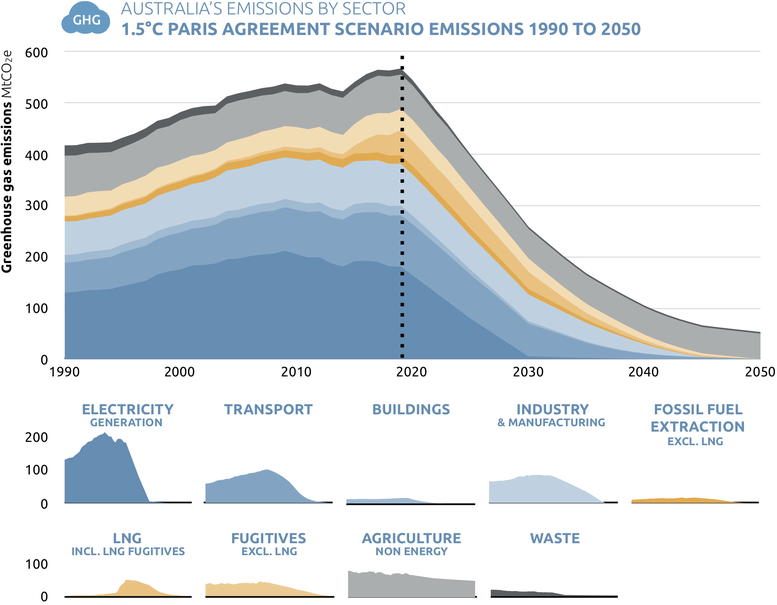
Our analysis starts with an in-depth review of Australia’s current policy framework and sectoral developments and compares them with the comprehensive policy packages and the progress of the kind of sector indicators required under Paris Agreement-compatible pathways. It then focuses on a scenario analysis showing how to scale up climate action in Australia to levels consistent with the Paris Agreement.
This report shows that Australia, has tremendous potential to scale up climate action in all sectors. Increasing climate action would initiate sectoral transitions towards a zero-emissions society with the additional benefits of reducing air pollution, and creating employment including through new manufacturing value chains and new export opportunities based on renewable energy.
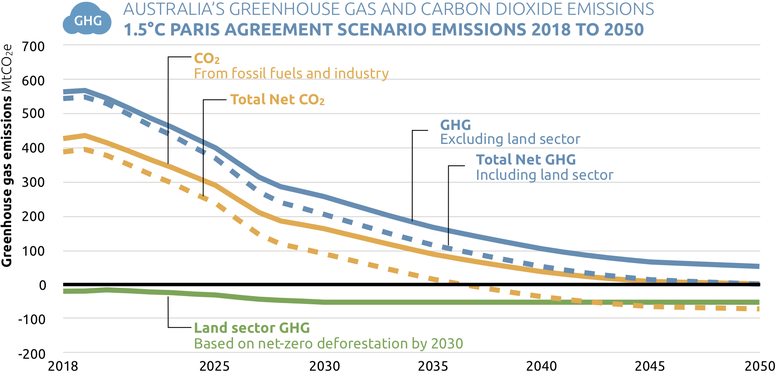
Key findings
- Australia’s 2030 Paris Agreement target and its domestic policies are not compatible with the Paris Agreement’s 1.5°C limit. Australia will need to accelerate its climate action across all sectors of the economy and ratchet up the 2030 climate target to put the country on a path towards net zero GHG emissions by 2050.
- Increased climate action in Australia will achieve a wide range of benefits and build on existing technologies and current market developments to achieve cost reductions, particularly for wind, solar and storage technologies by taking advantage of the country’s extraordinary renewable energy resources.
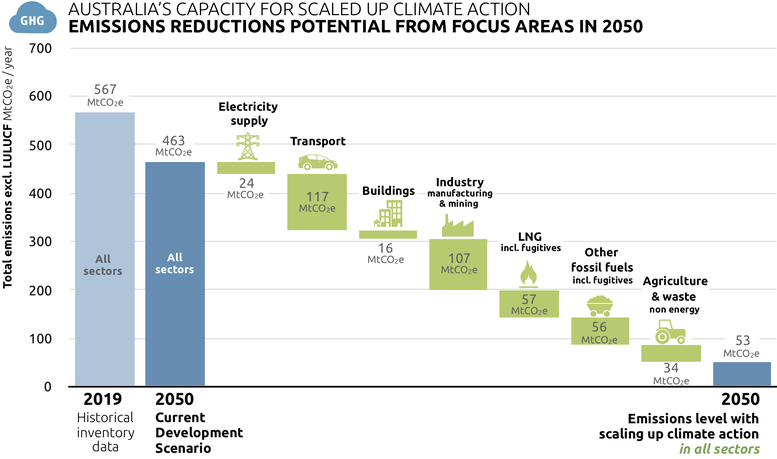
- Accelerated climate action in line with the Paris Agreement-compatible scenarios across all sectors allows Australia to achieve emission reductions of about 50% below 2005 emission levels by 2030, and 90% reductions by 2050, excluding the uncertain and volatile Land use, land-use change and forestry (LULUCF).
- To achieve net zero by 2050 Australia’s 2030 GHG reduction target (including LULUCF) needs to be about 66% below 2005 levels. This is very close to the high end of the 2030 target range recommended by the Climate Change Authority in 2014 of 47-65% below 2005 emission levels.
- Australia can achieve net zero GHG emissions by 2050 if it takes action to halt deforestation by 2030, and if it maintains the storage of carbon in forests projected for 2030 until 2050. This would be needed to outweigh remaining greenhouse gas emissions from hard-to-abate sectors, particularly agriculture. To achieve this the 2030 GHG reduction target (including LULUCF) would be about 66% below 2005 levels.
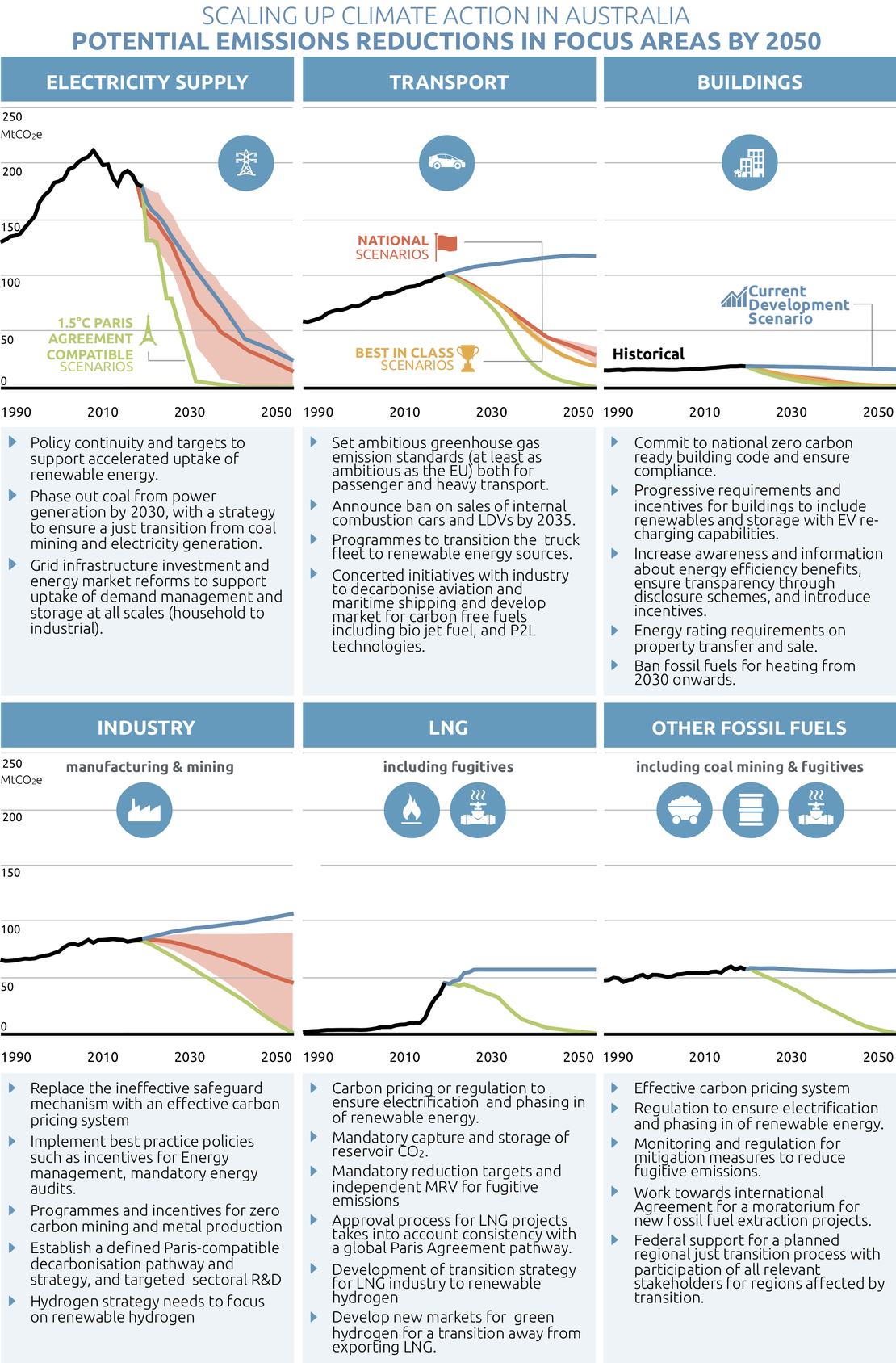
- Achieving net zero GHG emissions by 2050 will require a whole of economy approach, with mitigation in the non-energy sectors alongside decarbonising electricity and electrification of industry and transport, the roll-out of renewable hydrogen and a balanced approach in the land-sector that protects biodiversity, water resources and avoids relying on carbon storage in the land sector beyond sustainable limits.
- Accelerating the transition towards a zero carbon, renewables-based electricity supply by the 2030’s will bring large domestic employment opportunities to Australia with about 46,000 additional jobs between 2021-2030 compared to the current trajectory and, if combined with a policy to incentivise more local manufacturing of wind turbines, solar panels and batteries would reach 76,000.
- Australia can decarbonise its domestic energy system by 2050 by scaling up action in the electricity supply, and energy end use sectors (manufacturing industry, transport and building sectors) —which cover around 70% of the Australia’s current greenhouse gas emissions.
- Electrification of end-use sectors is central to decarbonising the Australian economy, including electric mobility and green hydrogen for industry and transport, with benefits for the electricity system.
- Australia needs to urgently prepare for the global transition away from fossil fuels as the world implements the Paris Agreement with many countries now aiming for zero emissions by 2050 and can develop alternatives to exporting fossil fuel energy.
- By building on its extraordinary renewable energy resource and high skills base, Australia can become a regional and international frontrunner in successfully transitioning its energy system to zero carbon. The result will be more sustainable employment, reduced levels of air pollution, water demand and new manufacturing value chains and export opportunities based on zero emissions energy carriers including renewable electricity offshore, green hydrogen and energy intensive products such as green steel.
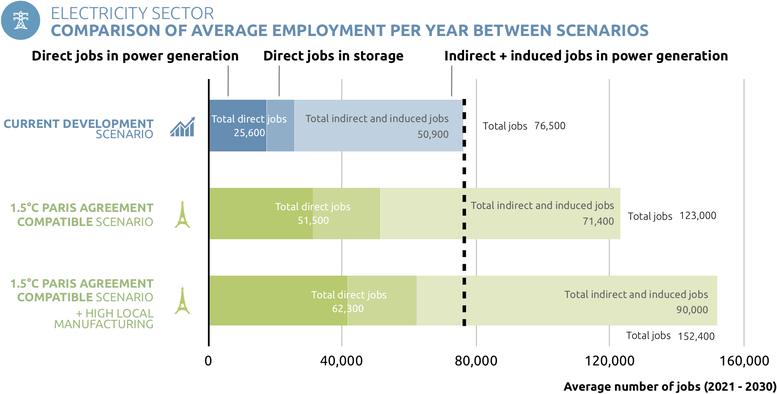
Electricity generation

Australia has no targets nor plans to increase the share of renewable energy beyond 2020. Under existing policies, Australia would likely reach a share of renewable energy in electricity generation nationally of around 50% by 2030 depending on state targets to be achieved.
- The electricity supply sector in Australia can be fully decarbonised, reaching 100% renewable energy by the mid to late 2030s given Australia’s prime renewable energy resources and technology developments for wind, solar, and storage already underway
- Coal can be phased out of the power sector by 2030 using renewables and advanced storage without additional gas generation needs.
- Coal phase-out plans are needed that will enable a smooth and just transition.
- Gas can be phased out of power sector by the mid to late 2030s using renewables and advanced storage. There is no role for an increase in gas use for power generation in a Paris Agreement-compatible pathway.
Renewable Energy and Green Hydrogen is a major opportunity for Australia
- Green hydrogen and other renewable energy-based fuels can be used to decarbonise industry processes to produce zero emissions steel or ammonia, and be used for aviation, shipping and freight transport through fuel cell trucks.
- Australia can benefit from its unique and abundant resources, both in renewable energy and the range of minerals and materials needed for a global transition to 100% renewable energy, but needs clear strategy and plan. It has the opportunity to become a global leader through, for example, exporting zero emissions energy carriers and products such as green steel.
Electric Mobility
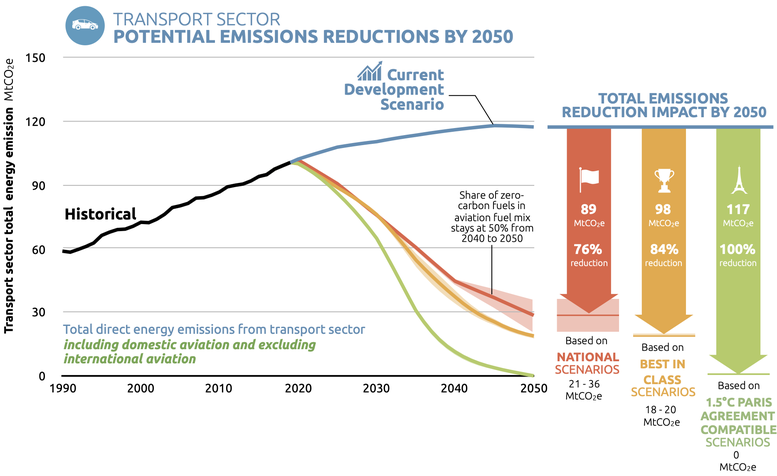
The upward trends of GHG emissions from the transport sector in Australia highlights the urgent need to accelerate action to fully decarbonise this sector by mid-century to be compatible with the Paris Agreement.
ð The phasing in of electric vehicles (EVs) with no fossil-fuel based vehicles sold from 2035 onwards will reduce air pollution and the need for imported fuel oil which presently imposes an import cost burden of 1.5% of GDP (in 2018) with import dependency expected to increase.
ð By accelerating EV market development fuel oil, usage would be reduced by 24% by 2030 from 2005 levels and 100% by 2050, resulting in an entirely decarbonised transport sector.
ð Integration of EVs into the Australian power grid will also provide substantial benefits for the electricity system, lowering costs and contributing towards integrating higher shares of variable renewables like wind and solar.
Reducing emissions from the LNG sector

Australia contributed to around one-fifth of total global LNG capacity in 2018, most of this from Western Australia. In 2019, Australia overtook Qatar to become the largest exporter of LNG in the world. The future trend of LNG export volumes will have a major effect on Australia’s domestic emissions. Renewable electrification of LNG processing plant can play a key role in phasing out emissions from LNG processing industry in Australia.
- Natural gas will need to phased out globally for power generation by the 2040s to meet the Paris Agreement goals, however the domestic LNG industry will need to reduce emissions well before that time.
- Australia can substantially reduce emissions from the LNG industry by capturing and storing carbon dioxide that would otherwise be emitted in very large volumes from natural gas reservoirs, using renewable energy for the process of liquifying natural gas and upstream pumping and transport of gas rather than use the gas itself, and, as well, reducing fugitive emissions from LNG plant and related processes.
- Transitioning the LNG manufacturing process away from gas to renewable electricity will also add significantly to the renewable energy market in Australia with opportunities for regional Australia.
Other sectors
This report also goes into details on what can be achieved in transport, buildings, industry, agriculture and waste. Please click on the link below to download the full and comprehensive report.
Stay informed
Subscribe to our newsletter
 Scaling Up Climate Action in Argentina
Scaling Up Climate Action in Argentina
 Scaling Up Climate Action in the EU
Scaling Up Climate Action in the EU
 Scaling Up Climate Action in Indonesia
Scaling Up Climate Action in Indonesia
 Scaling Up Climate Action in South Africa
Scaling Up Climate Action in South Africa
 Scaling Up Climate Action in Turkey
Scaling Up Climate Action in Turkey